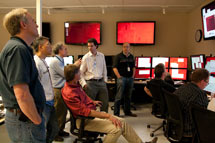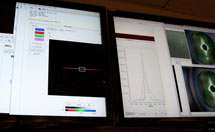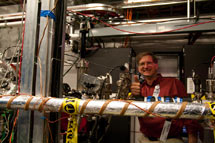
Handy Links
SLAC News Center
SLAC Today
- Subscribe
- Archives: Feb 2006-May 20, 2011
- Archives: May 23, 2011 and later
- Submit Feedback or Story Ideas
- About SLAC Today
SLAC News
Lab News
- Interactions
- Lightsources.org
- ILC NewsLine
- Int'l Science Grid This Week
- Fermilab Today
- Berkeley Lab News
- @brookhaven TODAY
- DOE Pulse
- CERN Courier
- DESY inForm
- US / LHC
SLAC Links
- Emergency
- Safety
- Policy Repository
- Site Entry Form

- Site Maps
- M & O Review
- Computing Status & Calendar
- SLAC Colloquium
- SLACspeak
- SLACspace
- SLAC Logo
- Café Menu
- Flea Market
- Web E-mail
- Marguerite Shuttle
- Discount Commuter Passes
-
Award Reporting Form
- SPIRES
- SciDoc
- Activity Groups
- Library
Stanford
Around the Bay
Second LCLS Instrument Sees First X-rays
For the first time, scientists at the SLAC National Accelerator Center pumped ultra-short X-ray pulses through the Soft X-ray Materials Research instrument yesterday. The team has begun aligning the beam for commissioning measurements, and the first shift of user experiments are slated for early July.
"This is a genuine team effort and everyone involved has been working at full speed for months," said Bill Schlotter, one of two instrument scientists who are coordinating the SXR commissioning launch.
The SXR instrument resides in the second experimental hutch along the Linac Coherent Light Source. The Atomic, Molecular and Optical Science instrument was the first to use beam from the LCLS in the fall of last year.
Over the next month, scientists will fine-tune the beam to work at its optimal performance. Yesterday they aligned the beam by threading it through a series of apertures barely larger than the beam itself. Today, they will adjust the monochromator, which selects a particular color or wavelength of the X-ray beam. In the days to come it will be calibrated so scientists can choose exact photon wavelength ranges to observe. The commissioning process also involves focusing the beam and correlating energy detectors, so that the number of photons coming through the beam can be measured along its length.
"I'm very happy. I'm very pleased to work with a lot of great people at SLAC to help make the project happen on time," said Michael Holmes, SXR operations engineer.
Because the SXR instrument uses such fast laser pulses—it flashes on for just femtoseconds—scientists will be able to take pictures of the secret play of atoms in fast chemical reactions. The first user experiments will probe how electrons behave in materials such as superconductors, metals that allow electricity to flow with no resistance. Scientists will also watch how thin metallic films can rapidly demagnetize, how ultrafast chemistry happens on surfaces, and the ultrafast chemistry of molecules in liquid solutions.
Soft X-rays are ideal for probing chemical reactions. Unlike "hard" X-rays that penetrate matter well, soft X-rays barely burrow at all when they deposit their energy in water, minerals or organic matter.
Researchers steer the beam and their experiments in a control room several meters away. From the control room, a handful of scientists can watch live footage of the beam. There are 14 cameras pointed at the X-ray laser and 30 motors that researchers control to make adjustments to alignment.
—Marissa Cevallos
SLAC Today, May 7, 2010


